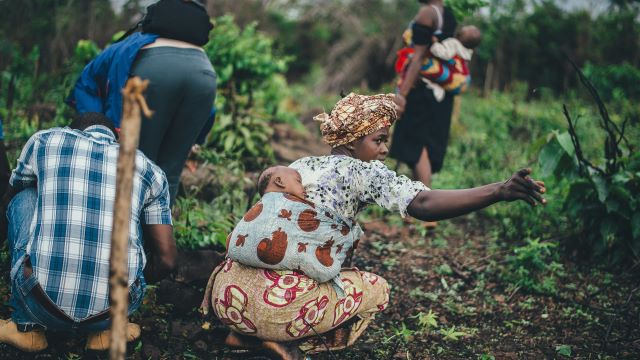By Fadila Ngatakou
BIMBO, Central African Republic — In the village of Gbaya-Dombia, the early light filters through acacia branches, casting long shadows over a patchwork of fields. The rhythmic swish of machetes cutting through weeds breaks the morning stillness. Around the edges of the clearing, a cooperative of women and young men works side by side, their hands roughened by years of labor, their expressions marked by quiet determination.
Across the Central African Republic (CAR), where fertile soil lies dormant under the weight of decades of political turmoil, small-scale community farming initiatives are reshaping the rural landscape. Beyond the rows of cassava and groundnuts, these projects are cultivating something less tangible but equally vital: economic stability, social cohesion, and the slow rebuilding of trust.
Once heavily reliant on food aid, rural communities are beginning to chart their own course. “We work together, we sell together. We feed our families,” said Martine Ngbélé, 42, who leads a cooperative of 37 farmers. In a country where over 70 percent of the population depends on agriculture but much of the arable land goes unused, such grassroots ventures are emerging as anchors in regions battered by conflict and neglect.
From Fallow Fields to Food Security
In Ombella-M’Poko, a western prefecture scarred by years of underuse, cooperative farms are reclaiming abandoned plots through partnerships between local NGOs and the United Nations Food and Agriculture Organization. Farmers receive starter kits — seeds, hand tools, and training in climate-resilient methods — in exchange for pooling labor and sharing profits.
The impact has been measurable. A 2023 International Fund for Agricultural Development report noted that production of maize and beans has tripled in some participating regions. Families once surviving on less than $1.90 a day now send children to school, open small shops, and invest in livestock.
“This is not charity,” said agronomist Benoît Gbané, who works with the Gbaya-Dombia cooperative. “It is about restoring autonomy.”
Healing Through Harvest
The gains are not only economic. In towns like Bossangoa and Kouango — where militia violence once made collaboration nearly impossible — cooperative farming has become a form of quiet reconciliation. Diverse groups work together in the fields, united by the demands of planting and harvest.
“The field doesn’t care who you are,” said 19-year-old Fatouma Alima, a participant in a Catholic Relief Services project in Ouaka. “When we plant, we plant together. When we harvest, we eat together.”
For many, these fields double as informal meeting grounds where disputes are resolved and rumors dispelled, a vital function in a country where official institutions remain fragile.
Persistent Obstacles
The challenges, however, remain steep. Roads are in disrepair, limiting market access. Equipment shortages force farmers to rely on hand tools, and mobile connectivity is unreliable. Climate change adds another layer of uncertainty, with erratic rainfall already disrupting recent harvests. The Ministry of Rural Development, itself underfunded, struggles to implement adaptation programs at scale.
The risk of renewed violence looms as well. Sporadic clashes in regions such as Vakaga and Haute-Kotto continue to displace communities and disrupt agricultural activity.
A Measured Optimism
Even so, new cooperatives are forming in remote areas, experimenting with agroecology and permaculture that merge traditional knowledge with modern techniques. Others are establishing savings groups or using solar dryers to preserve surplus crops.
International attention is slowly growing. The African Development Bank recently approved a $15 million investment for rural agribusiness, while diaspora networks provide microcredit and seed funding.
For farmers like Ngbélé, success is measured in tangible changes. “Last year, we bought a rice mill. Before, we pounded by hand. Now, we sell faster. We earn more,” she said.
By midday, the heat lies heavy over Gbaya-Dombia. A line of farmers rests in the shade, passing a gourd of water from hand to hand. Behind them, rows of cassava sway in the breeze — a living testament to what can grow when a community chooses to rebuild from the ground up.
Sources
- International Fund for Agricultural Development (2023). Annual Rural Development Report.
- Food and Agriculture Organization of the United Nations. Central African Republic Country Programming Framework.
- African Development Bank (2024). Rural Agri-Business Development Investment Package.
- Ministry of Rural Development, Central African Republic. Annual Agricultural Performance Review.


